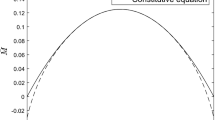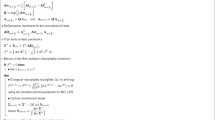Abstract
Strain localization is one of the most challenging phenomena in solid mechanics. It occurs when strains concentrate in very narrow bands within a solid, typically referred to as localization bands. This behaviour is related to different types of failure mechanisms: fracture, shear bands and slip lines. Being a dissipative process, the modelling of strain localization could seem to preclude the use of variational methods. However, a sound framework to deal with this issue has been developed in the last few decades. In this contribution, we review the modelling of strain localization by means of variational methods systematically, presenting the main underlying theoretical concepts. The issue of irreversibility is approached by means of the theory of generalized standard materials, which constitutes the basis for the variational approach. Then, typical problems occurring in the modelling of strain localization are analyzed: the tendency to localize in a band of zero thickness with no dissipation, the determination of the geometry of the localization band, and the orientation bias of such band with respect to mesh alignment in finite element discretizations. We discuss solutions for these problems, focusing on the approach that tackles the description of the localization band using phase fields.









Similar content being viewed by others
References
Alessi R (2013) Variational approach to fracture mechanics with plasticity. PhD thesis, Université Pierre et Marie Curie-Paris
Alessi R, Marigo JJ, Vidoli S (2014) Gradient damage models coupled with plasticity and nucleation of cohesive cracks. Arch Ration Mech Anal 214(2):575–615
Alessi R, Marigo JJ, Maurini C, Vidoli S (2017) Coupling damage and plasticity for a phase-field regularisation of brittle, cohesive and ductile fracture: one-dimensional examples. Int J Mech Sci 149:559–576
Alessi R, Ambati M, Gerasimov T, Vidoli S, De Lorenzis L (2018) Comparison of phase-field models of fracture coupled with plasticity. In: Oñate E, Peric D, de Souza Neto E, Chiumenti M (eds) Advances in computational plasticity. Springer, Cham, pp 1–21
Ambati M, Gerasimov T, De Lorenzis L (2015) Phase-field modeling of ductile fracture. Comput Mech 55(5):1017–1040
Ambati M, Kruse R, De Lorenzis L (2016) A phase-field model for ductile fracture at finite strains and its experimental verification. Comput Mech 57(1):149–167
Ambrosio L, Tortorelli VM (1990) Approximation of functional depending on jumps by elliptic functional via \(\gamma \)-convergence. Commun Pure Appl Math 43(8):999–1036
Ambrosio L, Lemenant A, Royer-Carfagni G (2013) A variational model for plastic slip and its regularization via\(\gamma \)-convergence. J Elast 110(2):201–235
Amor H, Marigo JJ, Maurini C (2009) Regularized formulation of the variational brittle fracture with unilateral contact: numerical experiments. J Mech Phys Solids 57(8):1209–1229
Armero F (2018) Elastoplastic and viscoplastic deformations in solids and structures. In: Stein E, de Borst R, Hughes TJR (eds) Encyclopedia of computational mechanics, 2nd edn. Wiley, Hoboken, pp 1–41
Borden MJ, Verhoosel CV, Scott MA, Hughes TJ, Landis CM (2012) A phase-field description of dynamic brittle fracture. Comput Methods Appl Mech Eng 217:77–95
Borden MJ, Hughes TJ, Landis CM, Anvari A, Lee IJ (2016) A phase-field formulation for fracture in ductile materials: finite deformation balance law derivation, plastic degradation, and stress triaxiality effects. Comput Methods Appl Mech Eng 312:130–166
Bourdin B, Francfort GA, Marigo JJ (2000) Numerical experiments in revisited brittle fracture. J Mech Phys Solids 48(4):797–826
Bourdin B, Francfort GA, Marigo JJ (2008) The variational approach to fracture. J Elast 91(1–3):5–148
Braides A, Dal Maso G, Garroni A (1999) Variational formulation of softening phenomena in fracture mechanics: the one-dimensional case. Arch Ration Mech Anal 146(1):23–58
Conti S, Focardi M, Iurlano F (2016) Phase field approximation of cohesive fracture models. Ann Inst Henri Poincare Non Linear Anal 33:1033–1067
Dal Maso G, Toader R (2002) A model for the quasi-static growth of brittle fractures: existence and approximation results. Arch Ration Mech Anal 162(2):101–135
Dal Maso G, Orlando G, Toader R (2016) Fracture models for elasto-plastic materials as limits of gradient damage models coupled with plasticity: the antiplane case. Calc Var Partial Differ Equ 55(3):45
De Borst R, Mühlhaus HB (1992) Gradient-dependent plasticity: formulation and algorithmic aspects. Int J Numer Methods Eng 35:521–539
de Borst R, Verhoosel CV (2016) Gradient damage vs phase-field approaches for fracture: similarities and differences. Comput Methods Appl Mech Eng 312:78–94
de Borst R, Pamin J, Geers MG (1999) On coupled gradient-dependent plasticity and damage theories with a view to localization analysis. Eur J Mech A Solids 18(6):939–962
Del Piero G (2013) A variational approach to fracture and other inelastic phenomena. J Elast 112(1):3–77
Faria R, Oliver J, Cervera M (2004) Modeling material failure in concrete structures under cyclic actions. J Struct Eng 130(12):1997–2005
Forest S, Lorentz E (2004) Localization phenomena and regularization methods. In: Besson (ed) Local approach to fracture, vol 1. Presses des Mines, Paris, pp 311–371
Francfort GA, Marigo JJ (1998) Revisiting brittle fracture as an energy minimization problem. J Mech Phys Solids 46(8):1319–1342
Fraternali F, Negri M, Ortiz M (2010) On the convergence of 3D free discontinuity models in variational fracture. Int J Fract 166(1–2):3–11
Gerasimov T, De Lorenzis L (2016) A line search assisted monolithic approach for phase-field computing of brittle fracture. Comput Methods Appl Mech Eng 312:276–303
Germain P, Nguyen QS, Suquet P (1983) Continuum thermodynamics. J Appl Mech 50(4b):1010–1020
Halphen B, Nguyen Q (1975) Generalized standard materials. J Mec 14(1):39–63
Jirásek M (2000) Comparative study on finite elements with embedded discontinuities. Comput Methods Appl Mech Eng 188(1–3):307–330
Jirásek M (2002) Objective modeling of strain localization. Revue française de génie civil 6(6):1119–1132
Jirásek M (2007) Mathematical analysis of strain localization. Revue européenne de génie civil 11(7–8):977–991
Loret B, Prevost JH (1991) Dynamic strain localization in fluid-saturated porous media. J Eng Mech 117(4):907–922
Lussardi L, Negri M (2007) Convergence of nonlocal finite element energies for fracture mechanics. Numer Funct Anal Optim 28(1–2):83–109
Mandal TK, Nguyen VP, Wu JY (2019) Length scale and mesh bias sensitivity of phase-field models for brittle and cohesive fracture. Eng Fract Mech 217:106532
Marigo JJ (2000) From Clausius-Duhem and Drucker-Ilyushin inequalities to standard materials. In: Maugin GA, Drouot R, Sidoroff F (eds) Continuum thermomechanics. Springer, Dordrecht, pp 289–300
Marigo JJ, Geromel Fischer A (2018) Gradient damage models coupled with plasticity and their application to dynamic fragmentation. In: Lambert DE, Pasiliao CL, Erzar B, Revil-Baudard B, Cazacu O (eds) Dynamic damage and fragmentation. Wiley, Hoboken, pp 95–141
Marigo JJ, Maurini C, Pham K (2016) An overview of the modelling of fracture by gradient damage models. Meccanica 51(12):3107–3128
Mesgarnejad A, Bourdin B, Khonsari M (2015) Validation simulations for the variational approach to fracture. Comput Methods Appl Mech Eng 290:420–437
Miehe C, Lambrecht M (2003a) Analysis of microstructure development in shearbands by energy relaxation of incremental stress potentials: large-strain theory for standard dissipative solids. Int J Numer Methods Eng 58(1):1–41
Miehe C, Lambrecht M (2003b) A two-scale finite element relaxation analysis of shear bands in non-convex inelastic solids: small-strain theory for standard dissipative materials. Comput Methods Appl Mech Eng 192(5–6):473–508
Miehe C, Hofacker M, Welschinger F (2010a) A phase field model for rate-independent crack propagation: robust algorithmic implementation based on operator splits. Comput Methods Appl Mech Eng 199(45):2765–2778
Miehe C, Welschinger F, Hofacker M (2010b) Thermodynamically consistent phase-field models of fracture: variational principles and multi-field FE implementations. Int J Numer Methods Eng 83(10):1273–1311
Miehe C, Teichtmeister S, Aldakheel F (2016) Phase-field modelling of ductile fracture: a variational gradient-extended plasticity-damage theory and its micromorphic regularization. Philos Trans R Soc A 374(2066):20150170
Miehe C, Aldakheel F, Teichtmeister S (2017) Phase-field modeling of ductile fracture at finite strains: a robust variational-based numerical implementation of a gradient-extended theory by micromorphic regularization. Int J Numer Methods Eng 111:816–863
Mielke A (2006) A mathematical framework for generalized standard materials in the rate-independent case. In: Helmig R, Mielke A, Wohlmuth BI (eds) Multifield problems in solid and fluid mechanics, vol 28. Springer, Berlin, p 399
Moës N, Belytschko T (2002) Extended finite element method for cohesive crack growth. Eng Fract Mech 69(7):813–833
Moës N, Dolbow J, Belytschko T (1999) A finite element method for crack growth without remeshing. Int J Numer Methods Eng 46(1):131–150
Mumford D, Shah J (1989) Optimal approximations by piecewise smooth functions and associated variational problems. Commun Pure Appl Math 42(5):577–685
Negri M (2007) Convergence analysis for a smeared crack approach in brittle fracture. Interfaces Free Bound 9(3):307–330
Negri M (2014) Quasi-static rate-independent evolutions: characterization, existence, approximation and application to fracture mechanics. ESAIM Control Optim Calc Var 20(4):983–1008
Nguyen QS (2000) Standard dissipative systems and stability analysis. In: Maugin GA, Drouot R, Sidoroff F (eds) Continuum thermomechanics. Springer, Dordrecht, pp 343–354
Oliver J (1989) A consistent characteristic length for smeared cracking models. Int J Numer Methods Eng 28(2):461–474
Oliver J, Huespe A, Samaniego E, Chaves E (2002) On strategies for tracking strong discontinuities in computational failure mechanics. In: Fifth world congress on computational mechanics, pp 7–12
Oliver J, Huespe A, Samaniego E (2003) A study on finite elements for capturing strong discontinuities. Int J Numer Methods Eng 56(14):2135–2161
Oliver J, Huespe A, Samaniego E, Chaves E (2004) Continuum approach to the numerical simulation of material failure in concrete. Int J Numer Anal Methods Geomech 28(7–8):609–632
Oliver X, Agelet de Saracibar C (2017) Continuum mechanics for engineers. In: Theory and problems, 2nd edn. https://doi.org/10.13140/RG.2.2.25821.20961
Peerlings R, Geers M, De Borst R, Brekelmans W (2001) A critical comparison of nonlocal and gradient-enhanced softening continua. Int J Solids Struct 38(44–45):7723–7746
Pham K, Marigo JJ (2010) Approche variationnelle de l’endommagement: I. Les concepts fondamentaux. C R Mec 338(4):191–198
Pham K, Marigo JJ (2010) Approche variationnelle de l’endommagement: II. Les modèles à gradient. C R Mec 338(4):199–206
Pham K, Amor H, Marigo JJ, Maurini C (2011) Gradient damage models and their use to approximate brittle fracture. Int J Damage Mech 20(4):618–652
Rabczuk T, Bordas S, Zi G (2010) On three-dimensional modelling of crack growth using partition of unity methods. Comput Struct 88(23–24):1391–1411
Rodriguez P, Ulloa J, Samaniego C, Samaniego E (2018) A variational approach to the phase field modeling of brittle and ductile fracture. Int J Mech Sci 144:502–517
Samaniego E, Belytschko T (2005) Continuum–discontinuum modelling of shear bands. Int J Numer Methods Eng 62(13):1857–1872
Simo JC, Oliver J, Armero F (1993) An analysis of strong discontinuities induced by strain-softening in rate-independent inelastic solids. Comput Mech 12(5):277–296
Tanne E (2017) Variational phase-field models from brittle to ductile fracture: nucleation and propagation. PhD thesis, Paris Saclay
Ulloa J, Rodríguez P, Samaniego E (2016) On the modeling of dissipative mechanisms in a ductile softening bar. J Mech Mater Struct 11(4):463–490
Ulloa J, Rodríguez P, Samaniego C, Samaniego E (2019) Phase-field modeling of fracture for quasi-brittle materials. Undergr Space 4(1):10–21
Vigueras G, Sket F, Samaniego C, Wu L, Noels L, Tjahjanto D, Casoni E, Houzeaux G, Makradi A, Molina-Aldareguia JM et al (2015) An XFEM/CZM implementation for massively parallel simulations of composites fracture. Compos Struct 125:542–557
Wu JY (2017) A unified phase-field theory for the mechanics of damage and quasi-brittle failure. J Mech Phys Solids 103:72–99
Acknowledgements
The first author would like to acknowledge that this work was completed while being in a sabbatical leave.
Author information
Authors and Affiliations
Corresponding author
Ethics declarations
Conflict of interest
The authors declare that they have no conflict of interest.
Additional information
Publisher's Note
Springer Nature remains neutral with regard to jurisdictional claims in published maps and institutional affiliations.
Rights and permissions
About this article
Cite this article
Samaniego, E., Ulloa, J., Rodríguez, P. et al. Variational Modelling of Strain Localization in Solids: A Computational Mechanics Point of View. Arch Computat Methods Eng 28, 1183–1203 (2021). https://doi.org/10.1007/s11831-020-09410-8
Received:
Accepted:
Published:
Issue Date:
DOI: https://doi.org/10.1007/s11831-020-09410-8




